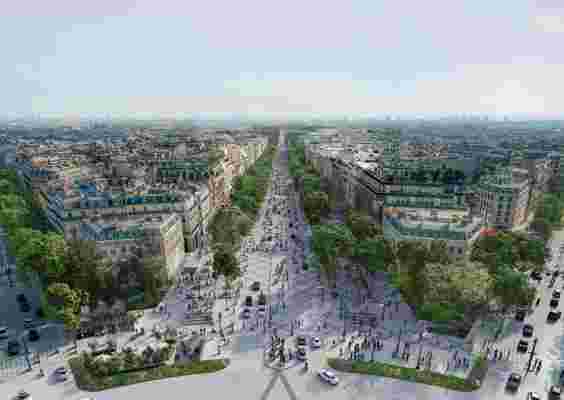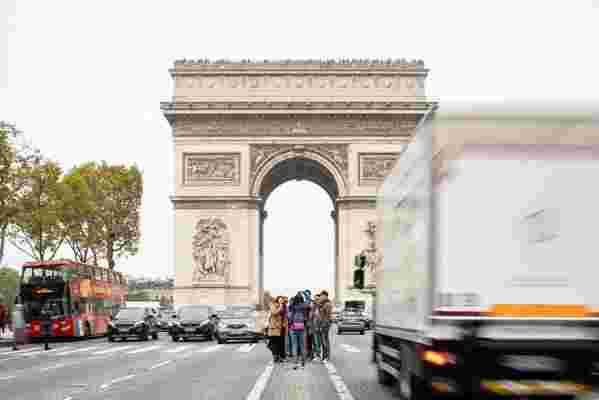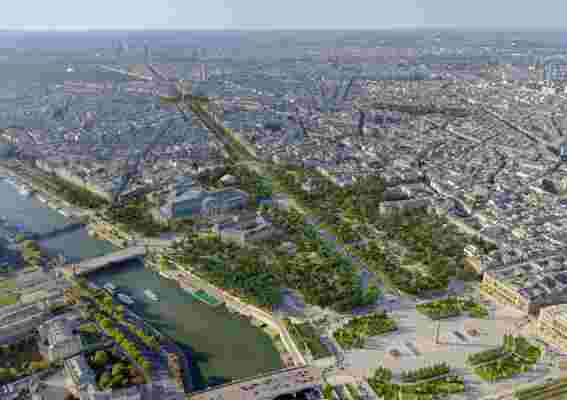December 16,2022
Paris’s Champs-Élysées Is Getting a Major Makeover—But What Does That Mean for the Locals?
by David Stewart
We might know Paris for the Eiffel Tower, but nothing can take the place of the Champs-Élysées. The sprawling promenade in the city’s 8th arrondissement is filled with perfumeries, cinemas, and high fashion boutiques. It’s usually as busy as New York's Times Square—but that could change.
Paris mayor Anne Hidalgo recently approved a $300 million plan to give the mile-long promenade a green makeover after Paris hosts the Summer Olympics in 2024. There will be hundreds more trees as well as larger sidewalks, less traffic, and a walkway that connects over 200 acres of green space, from the Arc de Triomphe through Place de la Concorde and the Tuileries Garden, which faces the Louvre Museum. “The culture is already there, you just have to open the door and organize a way to connect them,” says the architect, Philippe Chiambaretta from PCA-Stream .
It all started when the Champs-Élysées Committee , a local nonprofit, saw this 370-year-old promenade in decline. “From the 1930s to the 1970s, it was a chic hot spot for Parisians; it was culture with movie theaters and live music,” says Chiambaretta. “Now, retail and tourism has taken the place of culture. How can we change that?”

An aerial view shows the proposed changes to Paris's Champs-Élysées.
Right now, 64,000 vehicles a day pass through Champs-Élysées. Its air pollution is at an all-time high, with the levels of nitrogen dioxide two times greater than the limit set by the World Health Organization. The plan is to cut traffic in half.
It will certainly affect local businesses in the area, beyond the brands like Louis Vuitton, Cartier, and Galeries Lafayette. “It will have a big impact,” says David Holder, president of La Durée Paris, which has its flagship on the promenade. “With terraces, more trees, and more walking space, I’d love to see Champs-Élysées like this, it would be a dream come true.”
He explains it could help businesses recover from the pandemic, as sales have dropped by 80%. “Paris has many tourists, and you can’t come here without visiting the Champs-Élysées,” he says, “but tourists were declining even before COVID-19, so the mayor has to invest if she wants the tourists to come back.”

For decades, tourists have crammed together on a small medium to take photos and selfies. But that will change with the proposed renovation of the space.
The promenade has historic movie theaters and architecture from the Belle Époque era, as well as an Art Deco theater that opened in 1913, which hosted performances by Ella Fitzgerald. Hopefully, it can return to being a chic cultural hub. “Fifty years ago, Parisians came here to see a movie, dine, have ice cream, meet friends and family,” says Holder. “Now, it’s a place for tourists.”
Jean-Noël Reinhardt, president of the nonprofit Champs Élysées Committee , says that could change. “It has always been a cutting-edge place, one on the edge of the moment,” says Reinhardt. “But we have lost this sensibility. Now, it’s too many cars, overtourism, and pollution, but we hope it will become a quieter place in the future with beautiful gardens, less cars. We have to reinvent it as a beautiful promenade in the heart of Paris.”

The proposed plan would bring an abundance of new vegetation to the urban space.
The promenade faces the Arc de Triomphe, a war monument built in 1806. Tourists have typically stood in the middle of the street to take selfies. Chiambaretta’s plans include raised planks adjacent to the monument, like selfie platforms, so people can stay safe from traffic while taking photos.
This renovation will bring much-needed foot traffic postpandemic. Out of the 120 businesses on the street, 44 are currently closed. Foot traffic has dropped from 100,000 people a day to 30,000. “It will recover,” says Reinhardt.
The plan would also allow for smaller, kiosk-like pop-ups to be built.
To French chef Yannick Alléno, who runs the L’Abysse au Pavillon Ledoyen restaurant in the Jardin des Champs-Elysées, it’s a chance for the promenade to reinvent itself.
"I think it is important to think about how art could be more integrated in the Champs-Élysées territory,” said Alléno, in a statement. “It would be an opportunity to give work to young French artists, to enhance our cultural know-how. Cooking itself is a living art, which is logically part of the vegetable haven of these gardens too.”
While the amount of traffic would be limited, cars would still be able to drive through the Champs-Élysées.
The goal is to reduce carbon emissions by 2030, with a continuous green space that makes room for more cyclists and pedestrians in the heart of the city.
Chris Dercon, the director of the nearby Grand Palais, sees the opportunity. “I hope that we will soon have an overall vision bringing together all the establishments at the bottom of the Champs-Élysées, reconnecting them with the Invalides and thus creating a real cultural district,” he said in a statement.






